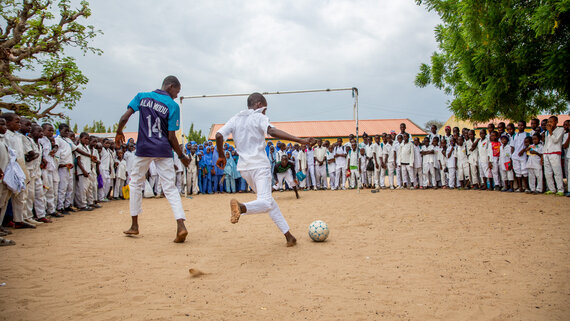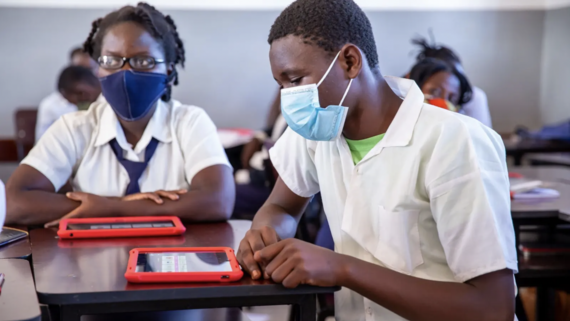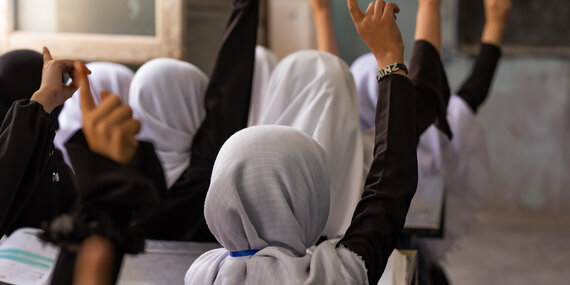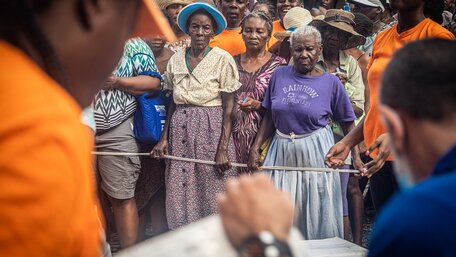Herat, Afghanistan
At the Mawlana Hatefi school for girls, only grades one to six have returned to learning. The school has high demand and a number of classes are held in tents due to funding shortages and lack of space. Around 4,000 girls attend this school when operating at full capacity for grades one to twelve. On last August, the authorities instructed schools in Afghanistan to reopen for grades one to six for both girls and boys in so-called ‘cold climate’ provinces. Grade seven and above remain closed with no clarity on when they will open again. Across Afghanistan, children’s education has been disrupted for two academic school years now due to the COVID-19 pandemic. UNICEF/Sayed Bidel
Significant disruptions to global education caused by COVID-19 continue. At the pandemic’s peak in 2020, school closures affected 1.6 billion students in 180 countries. This has resulted in education losses equivalent to about one half of a school year in emerging markets and developing economies and disproportionately affects children from poorer and less-educated families.
Between February 2020 and August 2021, schools were closed nationwide for more than 41 weeks in several countries included in the 2022 GHO, such as Bangladesh, Myanmar, Uganda and Venezuela. Other countries have implemented brief school closures amid rising cases, including in Iraq, Myanmar and Zimbabwe.
Vulnerable children are often the hardest hit by school closures - the longer they are out of school the less likely they are to return. Even before the pandemic, 127 million primary and secondary school-age children and young people in crisis-affected countries were out of school. By September 2021, schoolchildren around the world, including those in displacement situations, had lost an estimated 1.8 trillion hours of in-person learning, due to COVID-19 lockdowns.
Duration of school closures (2020-2021)
Despite many schools reopening in 2021, more than 870 million students face disruptions to their education and the protection that it provides. UNICEF estimates that 40 per cent of all school-age children across Eastern and Southern Africa - over 69 million children - were not in school in July 2021, due to pandemic-related closure, and adolescent girls are more likely than boys to fail to return to school.
As of 31 October 2021, countrywide school closures are still enforced in seven countries, of which six (Bangladesh, Honduras, Mozambique, Myanmar, Uganda and Venezuela) are included in the 2022 GHO. Global school closures due to COVID-19 show the fragility of education systems and the need for accessible and effective remote learning and child protection mechanisms that can be relied on when schools are forced shut.
Children affected by school closures
The global shift to remote learning has reduced education losses but also shown its limitations. Children and youth in humanitarian contexts often lack access to the technologies needed to learn remotely. About 2.2 billion, or two thirds of children and young people age 25 years or under, do not have Internet access at home. Households in rural areas are far less likely to have Internet access. Even when access is achieved, the cost of connectivity is prohibitive for many students and teachers. The greatest digital divides exist in Eastern and Southern Africa, East Asia and the Pacific, and Latin America and the Caribbean. Education losses are 70 per cent higher in economies that rank below the world average in access to electricity.
TV- or radio-mediated education programmes have been offered in some cases, but they do not support personalized learning or monitor attendance and progress. The full and specific needs of children with disabilities are often not accommodated in home-based learning. Increased investment in remote-learning programmes and infrastructure is key to building resilient education systems. Attempts are under way to improve the situation of people affected by this digital divide, but progress takes time as well as dedicated and sustained donor support.

Maiduguri, Nigeria
Children play football in the grounds of a school. During the pandemic in 2020, when all schools were closed, UNICEF collaborated with SUBEB to start the UNICEF Radio Hub, where students can learn multiple school subjects from teachers through radio learning programmes. The programme is successful and continues to stress that the right of every child to education should not be limited.
OCHA/Damilola OnafuwaWork has been accelerated on UNICEF’s Giga Initiative, which sets out to provide connectivity to every school in the world by 2030, and is mapping the location and real-time Internet connectivity of every school in the world. UNICEF’s Learning Passport provides a global online, mobile and offline learning platform that can help youth continue their education during emergencies that result in school closures. It is now live in 14 countries including Bangladesh, Honduras, Somalia (Puntland) and Sudan, and more than 25 countries are in the deployment process.
Instant Network Schools

The Vodafone Foundation and UNHCR have jointly established the Instant Network Schools (INS) programme, which supports access to quality, accredited digital education in Africa. Each INS is set up with free connectivity and includes a projector, laptop, speaker system and set of classroom tablets, enabling thousands of refugee and host-community students and teachers across Africa to access a quality, accredited digital education. Currently, INS is operating in DRC, Kenya, South Sudan and Tanzania. In 2021, the Vodafone Foundation and UNHCR announced the opening of 20 new INS centres in Egypt and Mozambique, which will benefit nearly 43,000 secondary-school students, 125,000 family members and over 1,500 teachers.
In the picture, a student at the INS in Maratane Refugee Settlement in Mozambique.
UNHCR/Vodafone Foundation/Sala LewisIt is important that schools are kept open wherever possible. Online learning alone cannot replace the overall benefits of children physically being in school. Beyond learning, schools often provide nutrition, health and hygiene services, and protection from violence and negative coping mechanisms, such as child marriage, child labour and enrollment by armed actors. School closures have exacerbated the risk of violence against adolescent girls, cutting them off from important social support networks. Sustained lack of access to these services means children’s overall welfare declines significantly. In the absence of vaccines, non-pharmaceutical interventions, such as social distancing, outdoor classes, and opening windows or doors for additional ventilation, can decrease the risk of transmission.
In his report titled Our Common Agenda, the UN Secretary-General has focused on learning and quality education as a clear priority and announced the convening of a Summit on Transforming Education in 2022 to accelerate progress towards achieving SDG 4.
Further reading
Source: UNESCO
Source: UNESCO
Source: ITU, UNICEF
References
- IMF, World Economic Outlook, April 2021, p. 58.
- IMF, Fiscal Monitor, April 2021, p. xii.
- UNESCO, Education: From disruption to recovery, October 2021.
- Ibid.
- UNICEF, Framework for Reopening Schools.
- UNHCR, Mid-Year Results COVID-19 Multisectoral Monitoring
- UNICEF, Schoolchildren worldwide have lost 1.8 trillion hours and counting of in-person learning due to COVID-19 lockdowns, says UNICEF, as of September 2021.
- UNICEF, 40 per cent of children in Eastern and Southern Africa are not in school, 27 July 2021
- Brookings, What do we know about the effects of COVID-19 on girls’ return to school?
- UNESCO, School Closure Monitoring, November 2021.
- UNHCR, Mid-Year Results COVID-19 Multisectoral Monitoring
- UNICEF, Reopening with resilience, September 2021.
- Ibid.
- IMF, World Economic Outlook, April 2021, p. 59.
- UNESCO, COVID-19 Education Response, Recovering lost learning: What can be done quickly and at scale? Issue note 7.4, p. 1. June 2021.
- UNHCR, Global Report, p. 220.
- UNICEF, Reopening with resilience, September 2021.
- UNICEF, Giga Initiative. Current focus countries are Rwanda, Kenya, Niger, Sierra Leone, Kazakhstan, Kyrgyzstan, Uzbekistan, El Salvador, Honduras, Dominica, Grenada, St. Lucia and St. Vincent.
- UNICEF, Learning Passport
- INEE, No Education, No Protection: What school closures under COVID-19 mean for children and young people in crisis-affected contexts
- IRC, What Happened? How the Humanitarian Response to COVID-19 Failed to Protect Women and Girls, October 2020, pp. 4, 7. and UNICEF, Where are the girls and why it matters as schools reopen?
- UNICEF, 40 per cent of children in Eastern and Southern Africa are not in school, 27 July 2021.
- OCHA, COVID-19 Data Explorer: Global Humanitarian Operations Monthly Highlights, 31 July 2021.
- Report of the UN Secretary-General, Our Common Agenda, p. 40. The summit will discuss a modernization of the education system, more student-centred learning, education obstacles faced by girls and young women, the transition from education to employment, and the promotion of lifelong learning and reskilling. Digital inclusivity will be a vital part of the summit, building on existing efforts such as the Giga Initiative.





